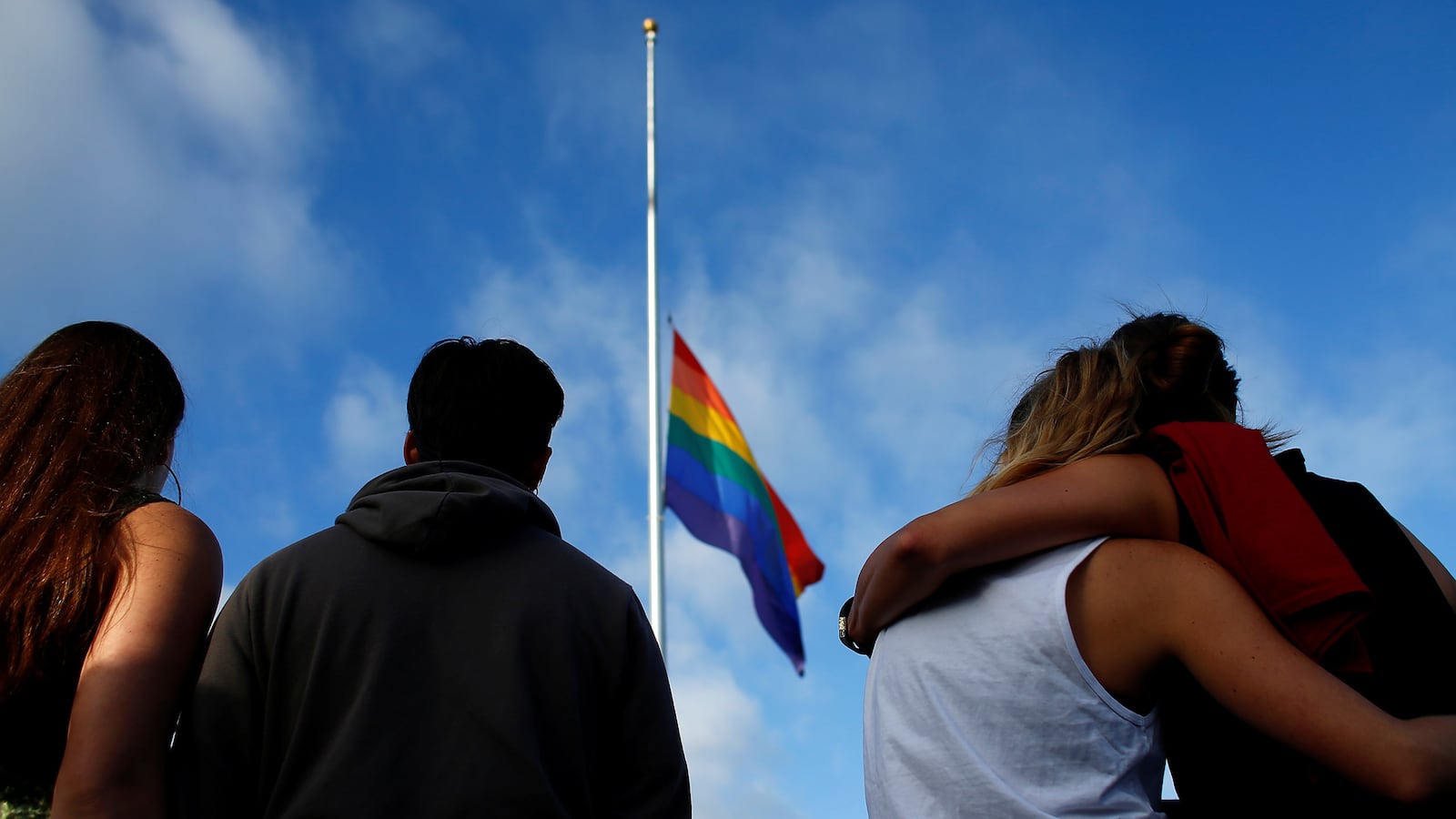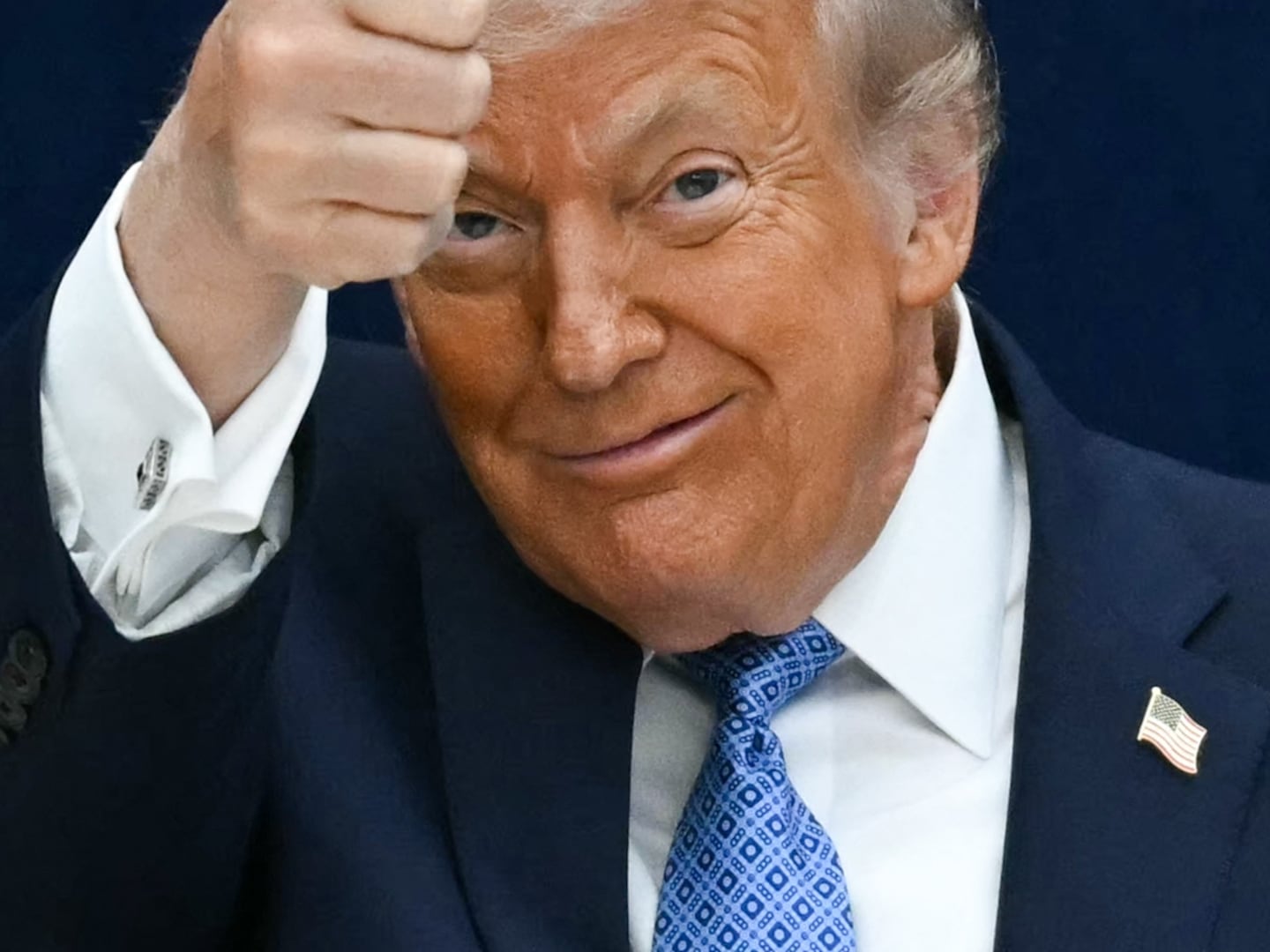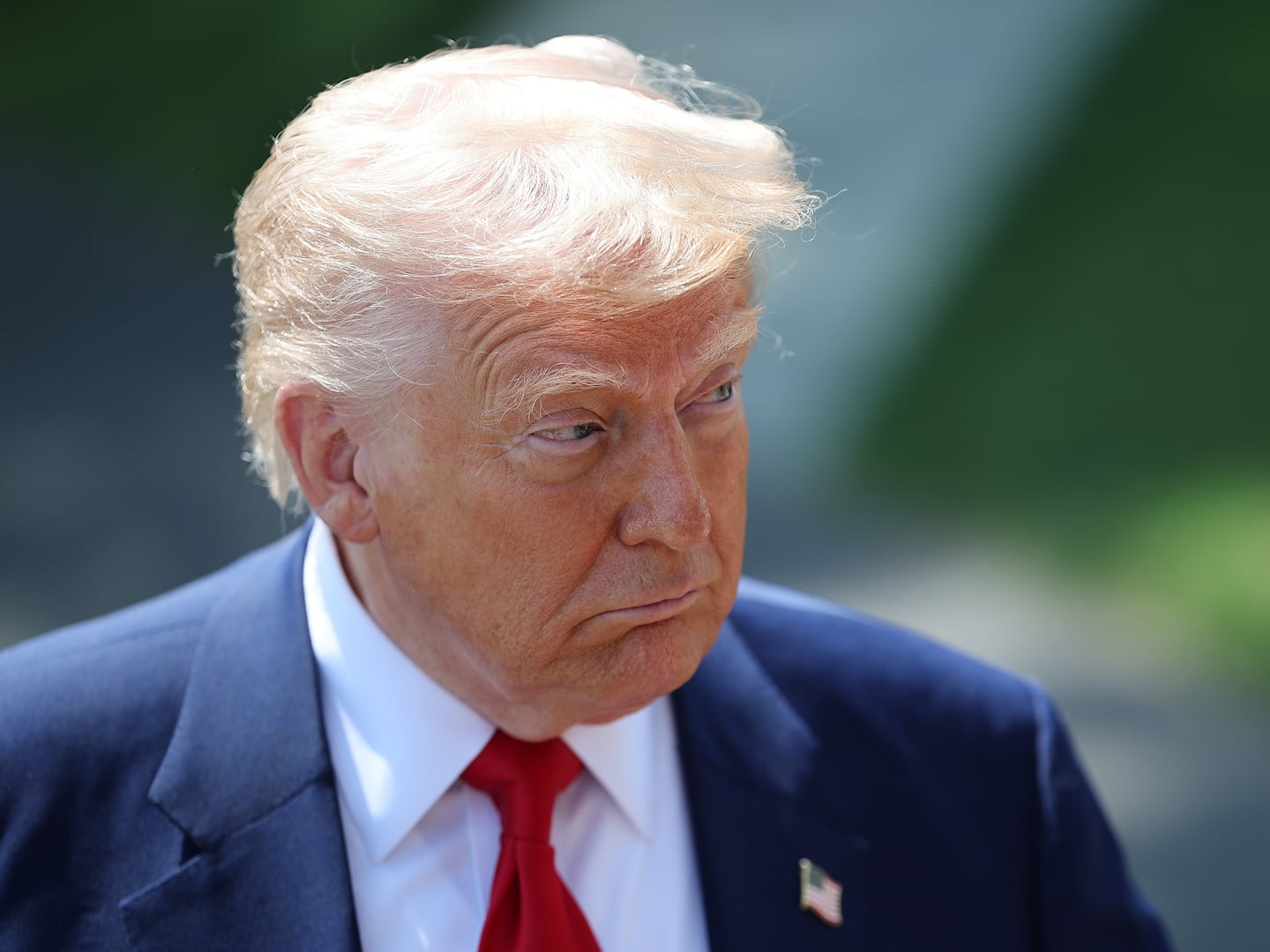The first time I went to Pride with my partner, both of us in matching rainbow T-shirts, we ran into Lea DeLaria, the actress who plays the butch inmate “Big Boo” on Orange is the New Black.
Starstruck, all I could think to do was prompt my partner to reveal that my nickname for her—also “Big Boo,” by complete coincidence—was inscribed on the inside of her wedding band. While DeLaria held the ring, smiling at the inscription, I hung back and snapped a photo—one of those perfect but grainy pictures that captures the raw feeling of a moment, right down to the sun catching the glint of the gold in her hands.
That moment in Atlanta in the fall of 2014 was teeming with possibility. Same-sex marriage wasn’t legal nationwide, but one day, I felt sure, that gold ring would be imbued with the force of law.
Transgender rights—my rights—were far from secure but then-President Obama seemed to be setting out on the right track and I felt a naïve sort of confidence that his successor would follow in those cautious early footsteps. I was four years younger, four years more hopeful, four years away from the dread that so many LGBT Americans felt on November 9 of last year.
I skipped Pride this year. It’s not that I don’t feel proud of the queer woman that I am. I’m just still trying to figure what Pride means in a moment that feels nothing like the future I once saw in that photograph.
Judging from the Pride events that have happened already this month, organizers are trying to figure out the exact same thing: Should they host corporate-sponsored parades with messaging as apolitical as the protest signs in a Kendall Jenner Pepsi commercial? Or should they lead sober resistance marches that revive the political heart of Pride, shunning commercialism and capitalist influence?
Should police officers be welcomed to march in uniform or should an event that traces its origins back to the Stonewall riots reject their presence, whether on principle or out of solidarity with Black Lives Matter?
As University of Washington History professor Laurie Marhoefer observed in a recent article for The Conversation, arguments along the radical-liberal line are as old as Pride itself—and even older.
In her estimation, the overall trajectory of Pride is “a story of a radical break with right-wing and even middle-of-the-road gay and trans politics.” Chanting “We’re here, we’re queer, get used to it” was once a radical act—and in some ways, it still can be. But depending on the shape of your “local pride march,” Marhoefer concedes, you might find only “traces of that [radical] history.”
Los Angeles eschewed some of its corporate sponsors in order to turn Pride into a Trump-era Resist March; other cities have gone about their business as usual. In D.C., LGBT activists interrupted the main event with chants like “No Justice No Pride” to call attention to power disparities and political differences within the community itself.
Through it all, media outlets like The New York Times and NPR and many more have been running articles that ask more or less the same question Buzzfeed’s recent headline asked: “Should Pride be a party or a protest?” (Hasn’t it always kind of been both?)
I would say that Pride is having an identity crisis this year—but then again, when has it not been having one? Internal tension is part of its beautifully messy DNA.
Indeed, the LGBT community has been asking questions like the ones we’re asking ourselves today for longer than I’ve been alive: Do we really want to wrap ourselves in rainbow-colored corporate regalia at a time when anti-LGBT figures have such a strong presence in the White House? Doesn’t that feel off, like wearing white to a funeral?
At the same time, shouldn’t we allow ourselves to have fun, to dance and celebrate, even—and perhaps especially—when things seem so dire? We managed to get this far being relentlessly playful in the face of despair, so why shouldn’t the beat go on?
I don’t know the answers to these questions. I’m not sure what the right balance is in 2017 between combatting anti-LGBT oppression and giving myself the space—and the permission—to smile and laugh and sing.
But I do know I can’t figure that out in a day—or even a month. Perhaps an endemic problem of Pride is how overdetermined a signifying event like it can become when it’s ostensibly meant for all 10 million of us in this country who identify as LGBT—10 million people who differ not just along political lines, but in our personalities, right down to our differing approaches to adversity.
Here’s where Pride month 2017 found me: Writing articles about how Texas could pass an anti-transgender “bathroom bill” this summer, about how 2016 was the deadliest year on record to be LGBT in this country, and about how Orlando 911 call taker Bill Hammer doesn’t know if the people he helped on the night of the Pulse nightclub shooting even survived.
All the while I was being bombarded with chipper PR emails about LGBT-themed merchandise and gay vacation packages and rainbow-colored this and rainbow-colored that. I don’t automatically begrudge companies for sending me these missives: many of them are donating portions of their proceeds to worthy charities, and often these new products and initiatives are the result of years of internal advocacy from LGBT employee resource groups who then see their hard work slammed by critics as so much corporate appropriation.
But there’s a certain tragic poetry in the juxtaposition between how bad things are right now and the unstoppable rainbow machinery that has built up around Pride.
This week, a company I won’t name sent rainbow-colored popsicles to The Daily Beast’s New York office, unsolicited, thinking that I worked there. I spent my morning tracking down the email of our facilities person so he could throw out the box before it started leaking all over the mailroom—and then I wrote about how the Department of Education has essentially left trans kids in the lurch on the bathroom issue.
I wasn’t so much mad at the company as I was painfully amused by this strange future. Four years ago, I was giddy to be at Pride. Now, I’m writing about how LGBT rights are eroding while rainbow popsicles melt in a cardboard box a thousand miles away.
In its nearly 50 year history, Pride may have seen worse times for LGBT people than these: the slow climb out of cultural invisibility in the 70s, the height of the HIV/AIDS crisis in the 80s, the culturally conservative regression that culminated in the 1996 Defense of Marriage Act.
One could make the argument that the obstacles of 2017 are milder, but my counterpoint would be that the most salient problems the LGBT community faces today still affect the people with the fewest resources to combat them.
Rates of new HIV infections remain alarmingly high among people of color and transgender people, who might not be able to afford the time or the money it would take to go march on Washington.
Transgender rights are under relentless attack at the federal and state level but, being transgender myself, I know that trying to get cisgender allies to care can sometimes feel like screaming into a void.
With same-sex marriage finally in the media’s rear view mirror, these often longstanding issues have come into sharper relief—but that attention has been a double-edged sword, one that cuts right through the heart of my relationship with Pride month.
Anti-LGBT forces know that we’re here. They know that we’re queer. And instead of getting used to it, they’re doubling down on their opposition.
They have crafted laws designed to discriminate against transgender people that require an alarming amount of research and calculation. Last week, six members of the Presidential Advisory Council on HIV/AIDS said that they had to resign because Trump “simply does not care” about the epidemic. The most urgent question now doesn’t seem to be how to announce our presence to the world but how to protect ourselves from the life-threatening consequences of visibility.
That’s why I feel as if I’ve aged decades in the four years since Lea DeLaria grinned at my partner’s ring. That’s why I don’t know what I would accomplish—personally or politically—by going to Pride this year.
It only took New York magazine writer Claire Landsbaum half the time as me to grow just as jaded. In a recent essay explaining her decision to skip New York City Pride in favor of the Dyke March, she wrote, “As a nervous 20-something dipping her toe into the queer community [in 2015], the Pride March felt right to me. But this year, I’d rather protest than parade.”
I’m not sure I even have it in me to protest. Only the ballot box matters to me now—you can get millions in the streets but unless crucial thousands show up in voting booths, opponents of LGBT equality will keep postponing the perhaps illusory future I saw in that photo I took back in 2013.
I will continue to live my life with pride. I will continue to be unafraid to be queer, in red and blue states alike. And I won’t rain on anyone’s parade, especially not Cincinnati’s where Lea DeLaria is serving as Grand Marshal this year.
Maybe one day, maybe next year, I’ll show up to make signs for a march or to have picnic with friends. And I have a fundamental respect for anyone who needs to get out and dance as much as I needed to write this essay.
But for now, it’s hard for me to get behind Pride with a capital P when everything I’m feeling is in lower case.






